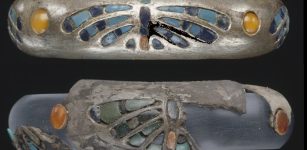Magnificent Golden Silk Cloth Made By 1 Million Spiders Is One Of The World’s Rarest Silk Textiles
Jan Bartek - AncientPages.com - This unique golden silk textile is so magnificent you would like to buy it, but it is no ordinary cloth available in the shops. The minor workers behind this marvelous creation were as many as 1.2 million spiders!
This is the largest piece of golden spider silk cloth in the world, and it goes without saying it is one of the rarest silk textiles you can come across.
A cape made from Madagascar Golden Orb spider silk exhibited at London's Victoria and Albert Museum. Credit: Cmglee - Public Domain
Producing the golden silk cloth was time-demanding. It took 80 especially skilled workers three years and thousands of working hours to create this creation that was first displayed at the American Museum of Natural History in New York some years ago.
Workers in Madagascar went out every morning and collected spiders in the wilds. The spiders were kept for about 20 minutes while they produced between 30-50 meters of thread. After doing their job, the spiders were released into their natural home environment. So, don’t worry, these small intelligent little animals were in no danger and never harmed.
After carefully extracting about 80 feet of silk filament from each of the arachnids and putting it in weaving cones, workers started producing this 11-foot by 4-foot textile. The result is beyond words, and today, it is the only large piece of cloth made from natural spider silk existing in the world today.
Textile experts Simon Peers and Nicholas Godley, who are the two leading men behind this project, say this textile is not about fashion. It is about creating something unique and extraordinary.
A closer look at the magnificent golden cape made by more than 1 million spiders.
Many of the world’s leading scientists have tried to “replicate the tensile properties of spider silk and apply it to all sorts of areas in medicine and industry, but no one up until now has succeeded in replicating 100 percent of the properties of natural spider silk.” 1
Producing spider silk is unfortunately tricky, “due to spiders’ territorial and cannibalistic nature, their silk has been impossible to mass produce, so practical applications have yet to materialize.” Once spiders are placed in the same environment they start attacking and eating each other.
Some years ago, scientists managed to create a biosynthetic spider silk that behaves like the real thing. In the near future, this type of biosynthetic spider silk may be even stronger making it “desirable for many applications ranging from super thin surgical sutures to projectile resistant clothing.” 2
Peers came up with the idea “of weaving spider silk after learning about the French missionary Jacob Paul Camboué, who worked with spiders in Madagascar during the 1880s and 1890s. Camboué built a small, hand-driven machine to extract silk from up to 24 spiders at once, without harming them.” 1
The cape’s “main weave is made up of 96 strands, the lining 48 strands, and its appliqué embroidery is made using unspun 24 strand silk. It is worth noting that on average of 23,000 spiders produce approximately 1 ounce of silk, only further emphasizing the rarity and uniqueness of these creations.” 3
Updated on March 6, 2022
Written by Jan Bartek - AncientPages.com Staff Writer
Copyright © AncientPages.com All rights reserved. This material may not be published, broadcast, rewritten or redistributed in whole or part without the express written permission of AncientPages.com
Expand for references- Hadley Legget - 1 Million Spiders Make Golden Silk for Rare Cloth. Wired.com
- Christopher H. Bowen, Bin Dai, Cameron J. Sargent, Wenqin Bai, Pranay Ladiwala, Huibao Feng, Wenwen Huang, David L. Kaplan, Jonathan M. Galazka, Fuzhong Zhang. Recombinant Spidroins Fully Replicate Primary Mechanical Properties of Natural Spider Silk. Biomacromolecules, 2018; DOI: 10.1021/acs.biomac.8b00980
More From Ancient Pages
-
 Magnificent Hattusa: Capital Of The Hittite Empire
Civilizations | Apr 11, 2021
Magnificent Hattusa: Capital Of The Hittite Empire
Civilizations | Apr 11, 2021 -
 Remains Of A 2,200-Year-Old Roman Fountain Discovered In Assos, Turkey
Archaeology | Aug 17, 2022
Remains Of A 2,200-Year-Old Roman Fountain Discovered In Assos, Turkey
Archaeology | Aug 17, 2022 -
 Evidence Vikings Had Windows With Glass Panes Already Between 800 And 1100
Archaeology | Oct 11, 2023
Evidence Vikings Had Windows With Glass Panes Already Between 800 And 1100
Archaeology | Oct 11, 2023 -
 Unexplained Cases Of Holographic Projections In Ancient And Modern Times
Featured Stories | Sep 14, 2018
Unexplained Cases Of Holographic Projections In Ancient And Modern Times
Featured Stories | Sep 14, 2018 -
 Chartres – Symbol Of Power And Secret Ancient Knowledge
Ancient Symbols | Nov 28, 2018
Chartres – Symbol Of Power And Secret Ancient Knowledge
Ancient Symbols | Nov 28, 2018 -
 Is ‘Someone’ Regularly Altering The Course Of History? – Unexplained Events – Part 2
Featured Stories | Dec 3, 2020
Is ‘Someone’ Regularly Altering The Course Of History? – Unexplained Events – Part 2
Featured Stories | Dec 3, 2020 -
 New Interpretation Of The Domesday Book Of William I The Conqueror
News | Jan 16, 2021
New Interpretation Of The Domesday Book Of William I The Conqueror
News | Jan 16, 2021 -
 Early Humans May Have First Walked Upright In The Trees 7 Million Years Ago
Human Beginnings | Dec 17, 2022
Early Humans May Have First Walked Upright In The Trees 7 Million Years Ago
Human Beginnings | Dec 17, 2022 -
 How Did Indus Civilization Manage To Resist Climate Change?
Archaeology | Feb 22, 2017
How Did Indus Civilization Manage To Resist Climate Change?
Archaeology | Feb 22, 2017 -
 4,000-Year-Old Funerary Garden Found In Luxor, Egypt
Archaeology | May 9, 2017
4,000-Year-Old Funerary Garden Found In Luxor, Egypt
Archaeology | May 9, 2017 -
 Mysterious Chakana – Sacred Inca Cross And Its Connection To The Southern Cross Constellation
Ancient Symbols | Sep 15, 2018
Mysterious Chakana – Sacred Inca Cross And Its Connection To The Southern Cross Constellation
Ancient Symbols | Sep 15, 2018 -
 These Curious Burials Could Challenge Historians’ Ideas About Anglo-Saxon Gender
Featured Stories | Oct 3, 2023
These Curious Burials Could Challenge Historians’ Ideas About Anglo-Saxon Gender
Featured Stories | Oct 3, 2023 -
 Danger Lurking In The Woods – Strange And Unexplained Sightings – Part 2
Featured Stories | Jul 7, 2018
Danger Lurking In The Woods – Strange And Unexplained Sightings – Part 2
Featured Stories | Jul 7, 2018 -
 Mystery Of Egyptian Queen Hetepheres I’s Bracelets Solved!
Archaeology | Jun 2, 2023
Mystery Of Egyptian Queen Hetepheres I’s Bracelets Solved!
Archaeology | Jun 2, 2023 -
 What Happened To The Ancient Tribe That Entered A Secret Underground World And Never Came Back?
Featured Stories | Feb 1, 2021
What Happened To The Ancient Tribe That Entered A Secret Underground World And Never Came Back?
Featured Stories | Feb 1, 2021 -
 Mysterious Valkyrie Eir Remains An Enigma In Norse Mythology
Featured Stories | Apr 4, 2018
Mysterious Valkyrie Eir Remains An Enigma In Norse Mythology
Featured Stories | Apr 4, 2018 -
 Chogha Zanbil: Huge Ancient Still Existing Ziggurat Dedicated To God Inshushinak
Featured Stories | Mar 10, 2016
Chogha Zanbil: Huge Ancient Still Existing Ziggurat Dedicated To God Inshushinak
Featured Stories | Mar 10, 2016 -
 On This Day In History: Bishop of Gloucester John Hooper is Burned At The Stake For Heresy- On Feb 9, 1654
News | Feb 9, 2017
On This Day In History: Bishop of Gloucester John Hooper is Burned At The Stake For Heresy- On Feb 9, 1654
News | Feb 9, 2017 -
 On This Day In History: Ramesses II Became Pharaoh Of Ancient Egypt – On May 31, 1279 BC
News | May 31, 2016
On This Day In History: Ramesses II Became Pharaoh Of Ancient Egypt – On May 31, 1279 BC
News | May 31, 2016 -
 Aboriginal Legends Tell Millennia-Old Stories Of Events In The Sky
Myths & Legends | Mar 6, 2015
Aboriginal Legends Tell Millennia-Old Stories Of Events In The Sky
Myths & Legends | Mar 6, 2015


